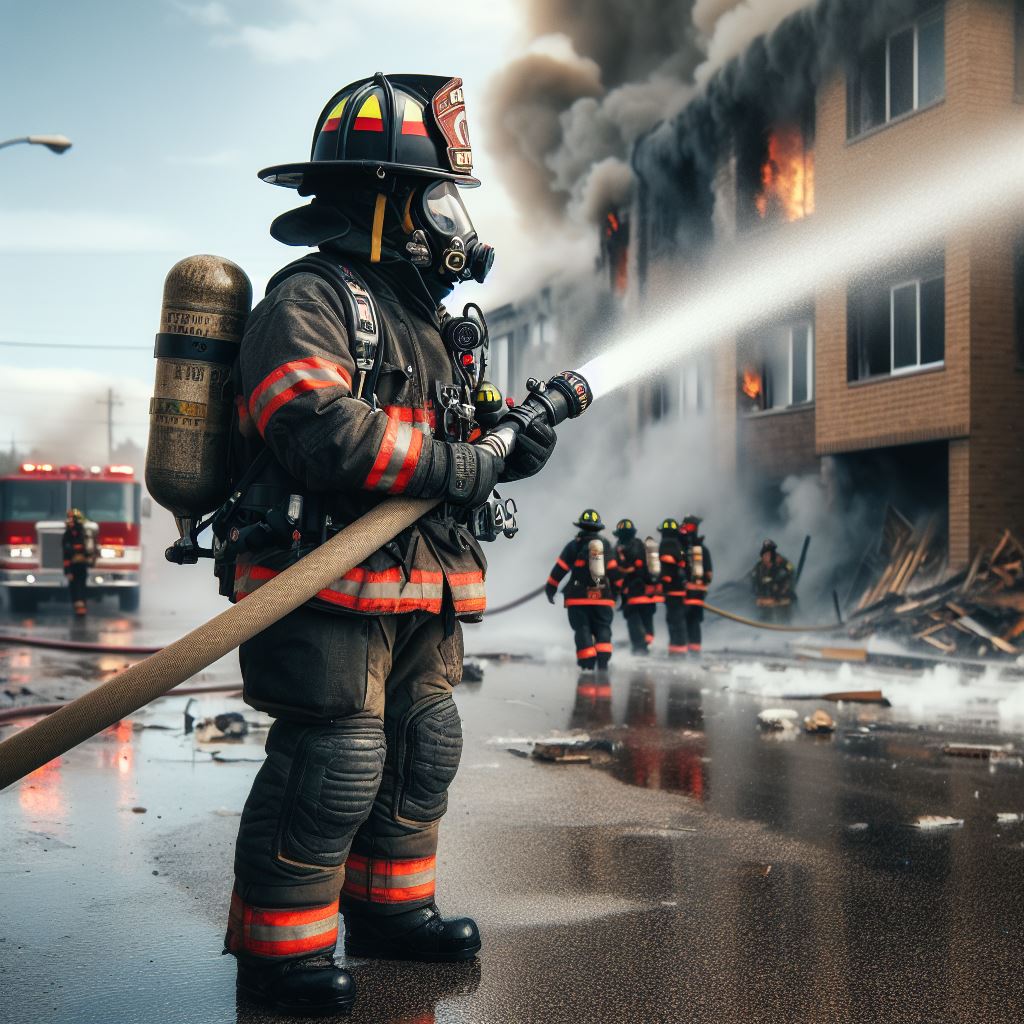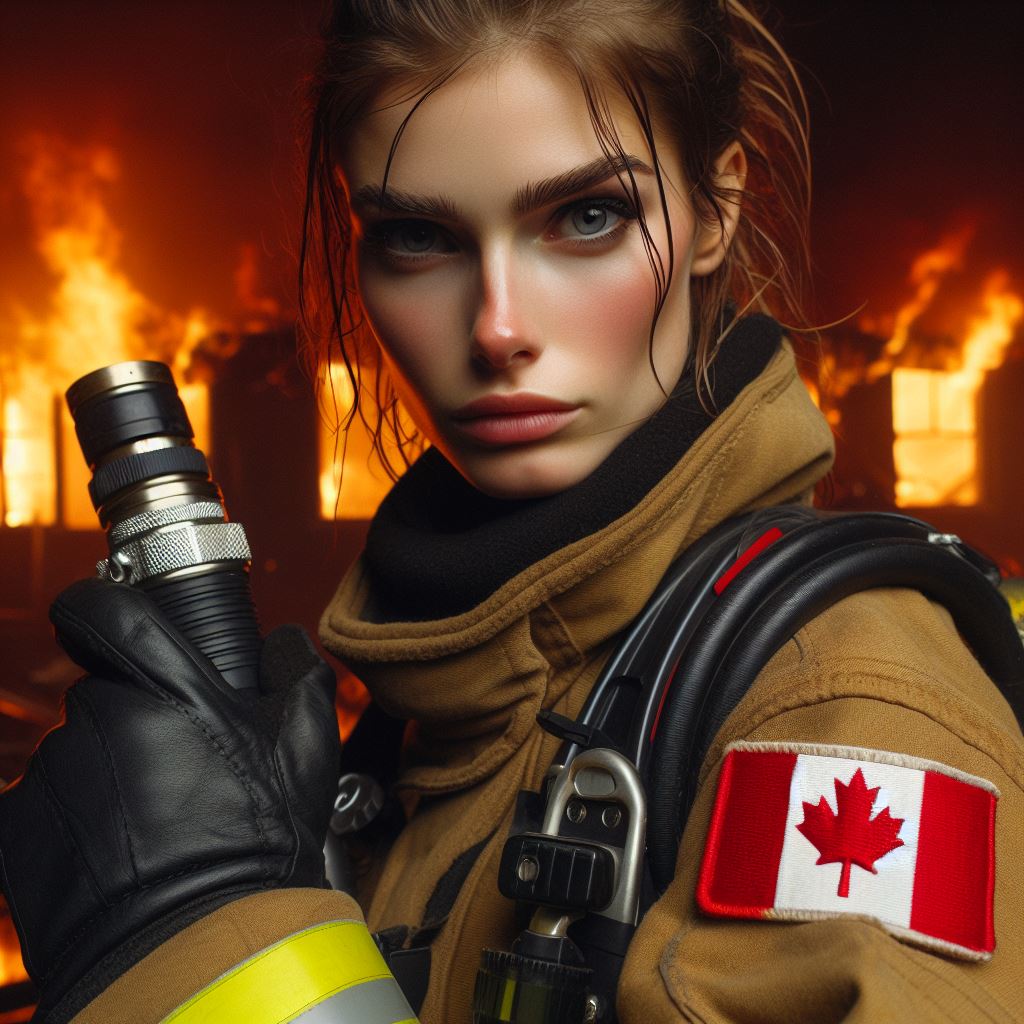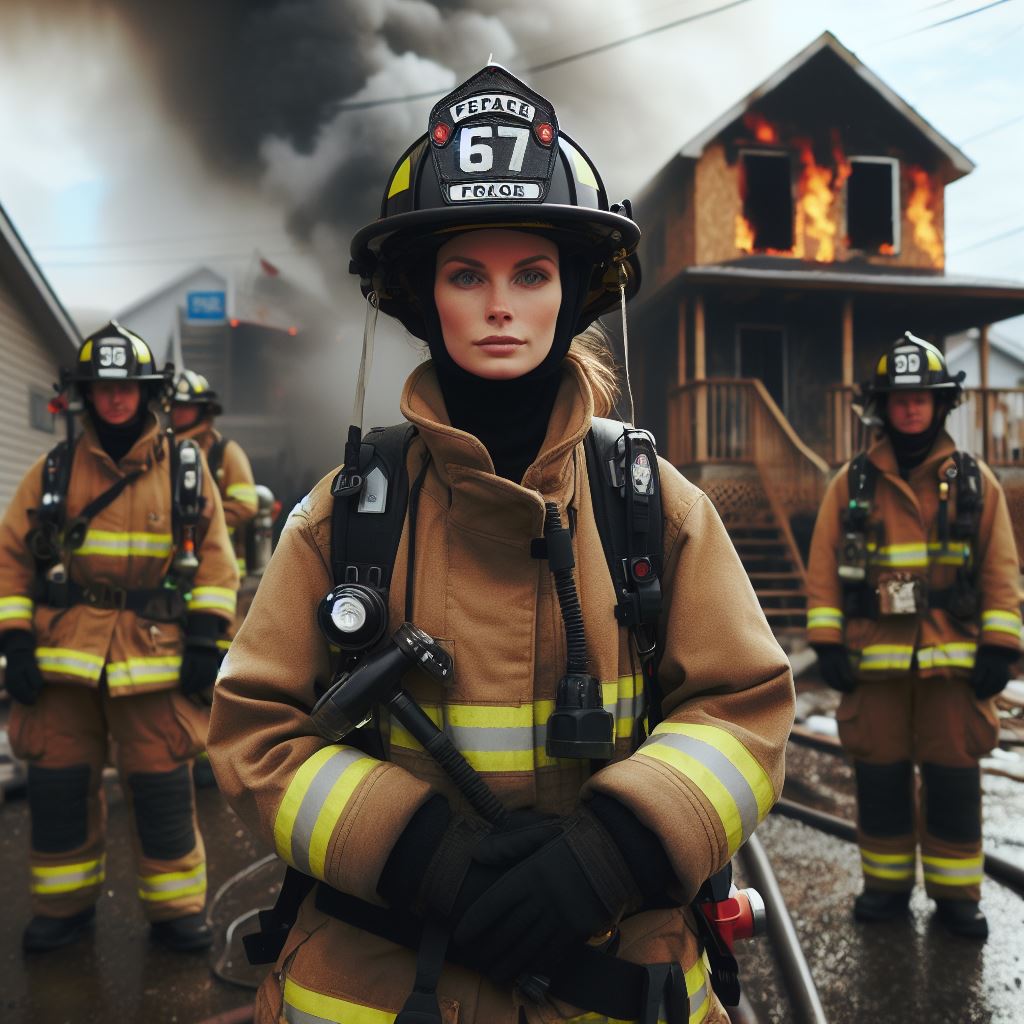Introduction
Firefighting is a challenging profession that requires individuals to have the right gear for the job.
In Canada, where weather and environmental conditions can be extreme, having the appropriate equipment is even more crucial.
Being a firefighter in Canada means facing unique challenges due to the country’s diverse climate and environmental conditions.
From freezing temperatures in winter to scorching heat in summer, firefighters must be prepared for any situation.
The importance of having the right gear cannot be overstated.
It not only ensures the safety of the firefighters but also enables them to carry out their duties effectively.
Firefighters need specialized clothing that provides protection against heat, flames, and falling debris.
Additionally, they require well-constructed boots with good traction for navigating slippery and uneven terrains.
Helmets are essential to protect their heads from falling objects and provide respiratory protection in hazardous environments.
Firefighters also rely on gloves to safeguard their hands from burns and cuts.
These gloves have a thermal barrier that prevents heat transfer, allowing firefighters to handle hot objects safely.
Furthermore, firefighters in Canada need to be equipped with self-contained breathing apparatus (SCBA) to protect themselves from smoke, toxic gases, and lack of oxygen in enclosed spaces.
In fact, the right gear is crucial for firefighters in Canada due to the country’s weather and environmental conditions.
Proper equipment enables firefighters to face the challenges they encounter with confidence and ensures their safety throughout their demanding and heroic duties.
Fire-resistant Clothing
Firefighters play a critical role in saving lives and properties during fire emergencies. To protect themselves from intense heat and flames, they rely on fire-resistant clothing.
Fire-resistant clothing is crucial to ensure their safety and effectiveness while extinguishing fires.
In Canada, firefighters use various types of fire-resistant clothing to combat the specific challenges they face.
These garments are designed to provide protection from the extreme temperatures associated with firefighting.
- Structural Firefighting Gear: One of the primary types of fire-resistant clothing used in Canada is the structural firefighting gear.
It consists of a protective jacket, pants, gloves, and a helmet. These garments are made of specialized materials such as Nomex or Kevlar. - Proximity Suits: Firefighters also utilize proximity suits, which offer increased protection in situations where they must approach intense heat or flames.
These suits provide a barrier against radiant heat, molten metal, and even chemical splashes. - Wildland Gear: For combating wildfires, firefighters wear specialized clothing known as wildland gear. This gear is designed to be lightweight, breathable, and offer protection from heat, hot embers, and smoke.
Features and materials used in fire-resistant clothing
Fire-resistant clothing incorporates several essential features and materials to enhance firefighter safety.
Outer Shell
The outer shell of fire-resistant clothing is typically made of a durable and heat-resistant material. It acts as the first line of defense against flames and hot surfaces.
Moisture Barrier
These garments often include a moisture barrier layer to protect firefighters from water and other liquids while ensuring breathability.
Thermal Barrier
Thermal barriers in fire-resistant clothing prevent heat transfer from the outer shell to the firefighter’s body, reducing the risk of burns.
Reflective Trim
Many fire-resistant garments incorporate reflective trim, which enhances visibility for firefighters working in low-light conditions.
Reinforced Stitching
Fire-resistant clothing features reinforced stitching to ensure durability, as firefighters operate in extreme environments.
Moisture-Wicking Liners
These clothing items include moisture-wicking liners that help keep firefighters dry by absorbing sweat and facilitating evaporation.
Unlock Your Career Potential
Visualize a clear path to success with our tailored Career Consulting service. Personalized insights in just 1-3 days.
Get StartedAdjustable Closures
Adjustable closures, such as hook-and-loop fasteners or buckles, allow firefighters to customize the fit of their clothing, ensuring mobility and comfort.
The materials used in fire-resistant clothing are carefully selected for their heat resistance and durability:
- Nomex: A synthetic fiber that offers exceptional heat and flame resistance properties, making it ideal for use in firefighter apparel.
- Kevlar: Known for its high tensile strength, Kevlar is used in fire-resistant clothing to provide excellent protection against cuts and abrasions.
- PBI: Polybenzimidazole (PBI) is a high-performance material that retains its strength even at high temperatures, making it suitable for firefighting gear.
- CarbonX: This fabric is inherently flame-resistant and provides protection against extreme heat and flames, commonly used in gloves and hoods.
In summary, fire-resistant clothing is of utmost importance for firefighters in Canada. It protects them from intense heat, flames, and various hazards they encounter during emergencies.
The different types of fire-resistant clothing, along with their features and materials, ensure the necessary safety and effectiveness for these brave individuals.
Protective Helmets
Protective helmets play a vital role in ensuring the safety of firefighters in Canada.
These helmets are specifically designed to safeguard firefighters from various hazards they face during firefighting operations.
Types of Helmets Used by Canadian Firefighters
- Traditional Helmets: Traditional helmets, also known as “salad bowls,” are made of fiberglass and provide basic protection against heat and falling debris.
- Modern Helmets: Modern helmets are constructed using advanced materials such as thermoplastics and composite fibers. They offer superior protection and durability.
- Combination Helmets: Combination helmets combine the features of traditional and modern helmets, providing enhanced safety along with comfort.
Key Features and Technologies in Modern Firefighting Helmets
- Thermal Protection: Modern helmets incorporate a thermal barrier that shields firefighters from intense heat and flames.
- Impact Resistance: These helmets are designed to withstand impacts from falling objects, protecting the head from injuries.
- Face Shields: Firefighting helmets often feature a retractable face shield to safeguard the face and eyes from heat, smoke, and debris.
- Integrated Communication Systems: Many modern helmets come equipped with built-in communication systems, allowing firefighters to stay connected during operations.
- Lightweight and Ergonomic Design: Firefighting helmets are designed to be lightweight and ergonomic, reducing fatigue and providing better mobility to firefighters.
- Reflective Trim: Helmets are equipped with reflective trim to enhance visibility in low-light conditions, improving safety at the scene.
- Moisture-Wicking Lining: Sweat-absorbing and moisture-wicking liners keep firefighters comfortable and dry during extended firefighting operations.
- Adjustable Suspension System: Helmets feature an adjustable suspension system to ensure a secure and comfortable fit for different head sizes.
- Noise Reduction: Some helmets feature built-in earmuffs or acoustic barriers to reduce noise levels, protecting firefighters’ hearing.
Given the evolving nature of firefighting risks, extensive research and development continue to enhance the design and functionality of firefighting helmets.
The incorporation of advanced technologies ensures that firefighters are well-equipped to face the challenges they encounter on the job.
It is crucial for Canadian firefighters to have the right protective helmets, as fires can be unpredictable and pose significant risks to their safety.
By investing in top-quality helmets with the latest features and technologies, firefighters can perform their duties with confidence and focus on saving lives and protecting property.
Read: Ethical Dilemmas Faced by Policemen

Breathing Apparatus
In firefighting situations, breathing apparatus is essential to protect firefighters from smoke, toxic gases, and lack of oxygen.
Types of Breathing Apparatus
Self-Contained Breathing Apparatus (SCBA)
SCBAs are commonly used by Canadian firefighters as they provide a self-contained air supply.
Airline Respirators
These breathing apparatus are connected to a remote air supply, allowing firefighters to work for extended periods of time.
Emergency Escape Breathing Devices (EEBDs)
EEBDs are small, portable apparatus that provide a short-term air supply during emergency situations.
Components and Capabilities
A breathing apparatus consists of the following components:
Facepiece
The facepiece is a mask that forms a secure seal and covers the nose and mouth, ensuring clean air.
Cylinders and Pressure Regulators
Cylinders contain compressed air or oxygen, and pressure regulators control the flow of air.
Hoses and Connections
Hoses carry air from the cylinder to the facepiece, with connections ensuring a tight and secure fit.
Harness and Straps
A harness and straps securely hold the breathing apparatus to the firefighter’s body during operation.
Integrated Communication System
Some breathing apparatus feature built-in communication systems, allowing firefighters to stay connected.
The capabilities of breathing apparatus are vital for firefighter safety and effectiveness:
Filtering and Purification
Breathing apparatus can filter out harmful particles and purify the air, ensuring it is safe to breathe.
Extended Air Supply
With a self-contained or airline system, firefighters have a longer air supply, enabling longer missions.
Heat and Flame Resistance
Breathing apparatus are designed to withstand high temperatures and protect against flames.
Visibility Enhancement
Some models include features such as built-in lights or thermal imaging systems to improve visibility in smoke-filled environments.
In short, breathing apparatus is a crucial piece of gear that allows Canadian firefighters to operate safely in hazardous environments.
By providing clean air, extended air supply, and protection against heat and flames, these devices enhance firefighters’ capabilities and protect their lives.
Read: Balancing Work-Life in Police Careers
Footwear and Gloves: Importance, Types, Features, and Materials
When it comes to firefighting in Canada, appropriate footwear and gloves are paramount for the safety and effectiveness of firefighters.
Let’s delve into the importance, different types, and the features and materials used in firefighting gear for the feet and hands.
Importance of Appropriate Footwear and Gloves
Firefighters face numerous hazards in their line of duty, including extreme temperatures, sharp objects, hazardous materials, and slippery surfaces.
Appropriate footwear and gloves are crucial for providing protection and ensuring optimal performance.
Both footwear and gloves enable firefighters to move and work in hazardous environments while minimizing the risk of injury.
Without them, firefighters would be exposed to burns, cuts, punctures, and other potential injuries.
Different Types of Footwear and Gloves
Firefighters in Canada use a variety of specialized footwear and gloves designed to meet the unique demands of their profession.
Here are some of the main types:
- Firefighting Boots: These boots are made from durable and heat-resistant materials, such as leather and rubber. They feature reinforced toes and soles for added protection against impacts and punctures.
- Wildland Fire Boots: Designed for fighting forest fires, these boots are lightweight but offer excellent protection against heat, embers, and sharp objects. They often have specialized tread patterns for enhanced traction on uneven terrain.
- Industrial Boots: Sometimes used by firefighters during certain operations, industrial boots are resistant to chemicals, oils, and other hazardous substances. They prioritize durability and slip resistance.
- Extrication Gloves: These gloves have heavy-duty construction with reinforced palms and fingers for optimal grip and protection when dealing with sharp objects and machinery during rescue operations.
- Structural Firefighting Gloves: These gloves are designed to protect against extreme heat and flames. They feature multiple layers of flame-resistant materials and thermal barriers to minimize burns.
- Wildland Fire Gloves: Lightweight and flexible, these gloves provide protection against heat and embers while allowing firefighters to maintain dexterity for tasks like handling tools and equipment.
Features and Materials for Protection and Functionality
In order to ensure utmost protection and functionality, firefighting footwear and gloves employ specific features and materials. Here are some common ones:
- Heat Resistance: Firefighting gear is designed to withstand extreme temperatures and direct flames. Heat-resistant materials like Kevlar, Nomex, and various combinations of thermal barriers are used to provide thermal insulation.
- Waterproofing: Since water is often an essential component used to extinguish fires, waterproof materials such as Gore-Tex are integrated into firefighting boots to keep feet dry and prevent discomfort.
- Chemical Resistance: Industrial boots and some gloves are made from materials that resist chemicals, oils, and other hazardous substances commonly encountered during certain firefighting operations.
- Reinforcements: To provide protection against impacts, punctures, and cuts, firefighting boots and gloves feature reinforced toes, soles, palms, and fingers made from tough materials like rubber, steel, or carbon fiber.
- Grip and Traction: Tread patterns, specially designed rubber outsoles, and grip-enhancing materials ensure firefighters have secure footing and excellent traction, even on slippery or uneven surfaces.
- Comfort and Flexibility: Despite their heavy-duty nature, firefighting footwear and gloves are designed to offer comfort and flexibility, allowing firefighters to perform their tasks with agility and without hindrance.
In general, suitable firefighting footwear and gloves are of utmost importance in Canada.
Through the use of various types, materials, and features, they protect firefighters from hazards and ensure their functionality in challenging environments.
By equipping firefighters with the appropriate gear, they can focus more effectively on their mission to save lives and protect communities.
Read: Canadian Police and International Cooperation
Tools and Equipment
When it comes to fighting fires in Canada, firefighters rely on a range of essential tools and equipment to ensure they can effectively combat different scenarios.
Each tool and piece of equipment serves a specific purpose and plays a crucial role in their operations.
Ergonomic Firefighting Gear
In any firefighting scenario, personal protective equipment (PPE) is of utmost importance.
Firefighters in Canada are equipped with specialized gear designed to safeguard them from extreme heat, flames, and hazardous materials.
This includes helmets, fire-resistant coats, pants, gloves, and boots.
Self-Contained Breathing Apparatus (SCBA)
One vital tool is the SCBA, which provides firefighters with a continuous supply of clean air.
It consists of a mask, regulator, air cylinder, and harness. SCBAs are crucial for entering smoke-filled and toxic environments.
Fire Extinguishers
Firefighters utilize various types of fire extinguishers depending on the nature of the fire.
Portable extinguishers, such as carbon dioxide (CO2) or dry chemical extinguishers, can quickly suppress small fires.
Fire Hoses and Nozzles
Firefighting hoses are essential for delivering water or fire suppressants to extinguish flames more effectively.
These hoses are coupled with different types of nozzles, allowing firefighters to control the direction and flow of water.
Specialized Equipment for Specific Scenarios
Different firefighting scenarios call for specialized equipment to handle unique challenges. Here are a few examples of tools tailored for specific situations.
Aerial Ladders and Platforms
In situations where fires or rescues occur at significant heights, aerial ladders or platforms are indispensable.
These extendable ladders or hydraulic platforms enable firefighters to access elevated areas and perform firefighting or rescue operations efficiently.
Thermal Imaging Cameras (TICs)
Thermal imaging cameras play a vital role in locating hotspots and identifying hidden fires.
These devices utilize infrared technology to capture heat signatures, allowing firefighters to navigate through smoke-filled environments and locate victims.
Rescue Tools
Firefighters in Canada rely on vital rescue tools for efficient operations. “Jaws of Life,” including hydraulic spreaders, cutters, and rams, are indispensable for extricating individuals from emergencies like vehicle entrapment or collapsed structures.
These tools ensure swift and precise actions during rescue missions, showcasing the prowess of Canadian firefighting teams.
The hydraulic tools, specifically designed for varied scenarios, empower firefighters to respond effectively to diverse challenges.
In demanding situations, these instruments become lifelines, allowing professionals to navigate through complex rescue scenarios with speed and accuracy.
With an active commitment to safety, Canadian firefighters equip themselves with these essential tools, embodying the proactive approach that defines their readiness for any emergency.
The “Jaws of Life” remain emblematic of the critical gear that underscores the heroic efforts of firefighters across Canada.
Positive Pressure Ventilation (PPV) Fans
In Canada, firefighters rely on indispensable tools, like Positive Pressure Ventilation (PPV) Fans, for effective firefighting operations.
These fans play a pivotal role in eliminating smoke, heat, and toxic gases from confined spaces.
Operating on a principle of pushing fresh air into targeted areas, PPV fans forcefully expel contaminated air.
This active approach ensures a swift and efficient removal of hazards, enhancing the safety and effectiveness of firefighting efforts.
The reliability and versatility of PPV fans make them a cornerstone in the essential gear lineup for Canadian firefighters, providing a crucial advantage in the challenging scenarios they often encounter.
As frontline defenders, equipped with cutting-edge tools, firefighters stand ready to safeguard lives and property across the diverse landscapes of Canada.
Water Pumps
Firefighting crews must have reliable water pumps capable of delivering high-pressure water streams to extinguish fires.
These pumps can draw water from various sources, such as hydrants or natural bodies of water.
The Functionality and Importance of Tools and Equipment
Each tool and equipment item serves a specific function that collectively supports the overall firefighting operation.
For example:
- SCBAs protect firefighters from smoke inhalation and the risk of asphyxiation.
- Fire extinguishers allow quick suppression of small fires before they escalate.
- Fire hoses and nozzles provide an effective way to deliver water and control fire spread.
- Aerial ladders and platforms enable safe access to elevated areas for rescue or firefighting.
- Thermal imaging cameras assist in locating hidden fires and identifying potential hazards.
- Rescue tools like the “Jaws of Life” aid in extricating trapped individuals safely and efficiently.
- PPV fans improve visibility and ventilation in smoke-filled environments, enhancing firefighter safety.
- Water pumps ensure a steady supply of high-pressure water to suppress flames effectively.
In essence, firefighters in Canada rely on a wide range of essential tools and equipment to carry out their duties and protect lives and property.
Each item plays a crucial role in ensuring their safety and effectiveness in different firefighting scenarios.
Read: Youth Outreach Programs by Canadian Police
Conclusion
In Canada, firefighting demands top-notch gear. Helmets shield heads from heat, while flame-resistant suits safeguard against intense blazes.
Boots with sturdy soles provide stability on uneven terrains. Oxygen tanks, a lifeline in smoke-filled environments, are indispensable.
Thermal imaging cameras aid visibility amid thick smoke, enhancing rescue precision. High-visibility jackets ensure easy identification in chaotic scenes.
Gloves crafted for dexterity enable intricate tasks. Communication devices foster seamless coordination during operations.
Flashlights illuminate darkness, vital in nighttime rescue missions. Fire-resistant hoods protect the face and neck from scorching temperatures.
Finally, medical kits address immediate injuries on the field.
Collectively, this gear empowers Canadian firefighters, enabling them to face unpredictable challenges with resilience and safeguard the communities they valiantly serve.




